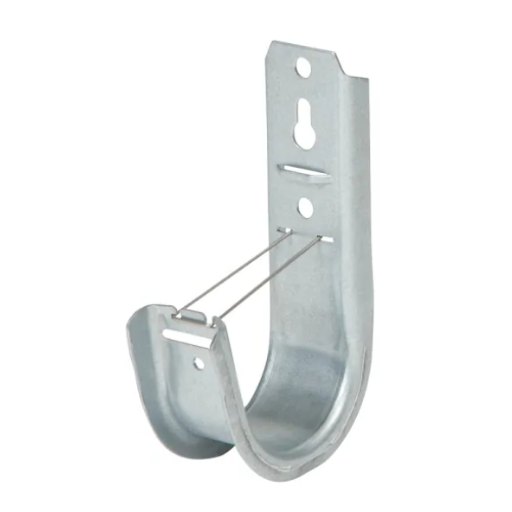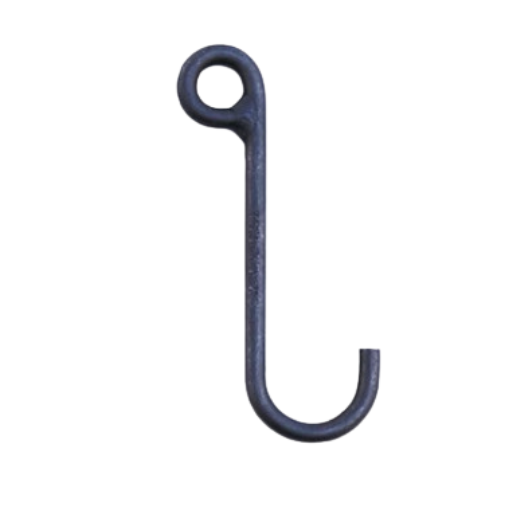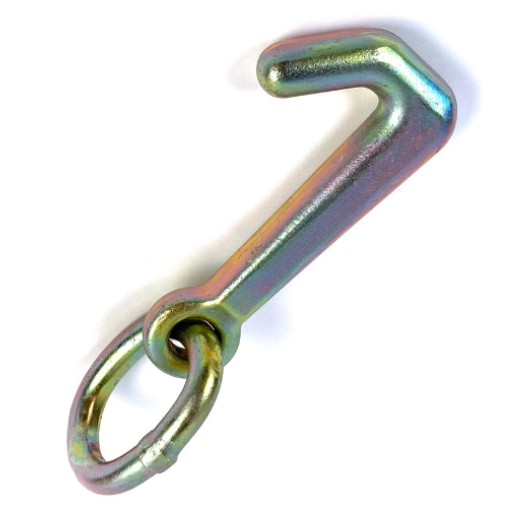J Hooks are a highly versatile and effective tool used in cable management. As their name suggests, these hooks are shaped like the letter ‘J’ and are designed to support and organize cables in various settings.
J Hooks are specially designed hooks used in various cable management scenarios. They are used to organize and support cables, ensuring they are neat and kept away from harm’s way. The hooks are commonly used in data centers, offices, homes, and industrial facilities where cable management is crucial. With J Hooks, cable installers can easily route and organize cables to ensure they are accessible, well-organized, and protected from accidental damage.
J Hooks provide a secure and stable platform that supports the weight and distribution of cables. They typically feature a curved design that prevents the wires from bending or crimping, which can damage them over time. With J Hooks, lines are held off the ground, protecting them from damage that spills, vandalism, or accidental kicking can cause. Additionally, the hooks can be mounted on walls, ceilings, or racks to save space and reduce Clutter.
J Hooks are designed to manage various cables, including fiber optic, data, electrical, coaxial, and telecommunications cables. This makes them suitable for multiple industries, including data centers, telecommunications, and industrial facilities.
J Hooks can be made from various materials, including plastic, zinc-coated, and stainless steel. The choice of material depends on the intended use and environment. For example, plastic J Hooks are suitable for use in areas where moisture is present, while steel hooks are ideal for use in industrial settings.
J Hooks come in various sizes, ranging from small to large. The hook size required depends on the cable size and its weight. For instance, a small J Hook is suitable for managing lightweight cables, while a larger angle is ideal for heavier cables, such as power cables. Choosing the right size of J Hook for the line is essential to prevent damage.
J Hooks are an efficient and cost-effective solution to cable management needs. These hooks come in various shapes and sizes, each with unique properties that suit different cables and environments. Here are some essential factors that you should consider when selecting a J Hook for your specific needs:

The type of cable you are using is a vital factor when selecting J Hooks. Different lines have different sizes and weights, and choosing the wrong J Hook can damage your pipes, affect performance, and pose safety risks. Ensure you select a J Hook that matches the cable type, whether coaxial, power cables, or fiber-optic.
The environment where the J Hooks will be installed also plays a crucial role. Any exposure to outdoor elements such as rain, sun, and wind will require a specific type of J Hook that can withstand harsh weather conditions. Also, if the installation area has chemicals or gases, you must use a J Hook that can withstand corrosive environments.
Selecting a J Hook that can support the weight of the cables you are managing is essential. Overloading a J Hook can result in it breaking or pulling out of its mounting surface. Every J Hook should have a maximum load capacity rating specified, and be sure to select one higher than your cables’ weight.
The maximum load capacity of J Hooks will vary depending on the manufacturer and the J Hook’s design. Various factors, including the hook’s length and diameter, the material’s thickness, and the mounting surface, can influence a J Hook’s capacity. Reviewing and understanding the manufacturer’s specifications before selecting a J Hook for your cables is essential. Remember to identify the weight of your lines and ensure it does not exceed the maximum load capacity of the J Hook.
Selecting the correct J Hook size ensures the cables are securely placed while promoting good routing and maximum performance. The diameter of your lines determines the size of the J Hook. The hook’s circumference should be large enough to fit the cable’s diameter comfortably without applying any pressure. Too small an angle will result in the cable crushing, while too large a turn will hang your lines loosely. Review the J Hook size chart provided by the manufacturer to choose the J Hook size compatible with your pipes.
Yes, J Hooks can be used for wall and ceiling mounting. Wall mounting might be the preferred option when the cable runs horizontally from room to room, while ceiling mounting works better when the cable path is vertical. When wall-mounting J Hooks, ensure they are installed at a level that provides maximum damage protection from people, chairs, machines, and other objects that might impact the cable.
To improve efficacy, there are various additional accessories you can add to J Hooks. These include cable support bridges, angle brackets, and cable ties. Cable support bridges create additional support for cables that need multiple hooks to avoid overloading a single J Hook. Angle brackets are helpful when adding J Hooks in difficult wiring areas such as corners or uneven surfaces. Cable ties help bundle cables together to provide an organized and neat look while reducing cable and equipment damage due to cable entanglement.
J Hooks are popularly used for cable management as they provide an effective solution for routing and securing cables in various environments such as data centers, offices, and homes. To ensure their effectiveness, proper installation and maintenance are crucial.

When installing J Hooks, proper planning and calculations must be made to ensure that the appropriate number of hooks is used, the correct spacing is achieved, and weight limits are not exceeded. Here are some recommended installation methods:
Calculate the cable weight: Before installation, calculate the importance of the cables that will be hung on the J Hook. This information is essential to determine the number of hooks required and their spacing.
Locate the attachment point: Determine where the J Hooks will be attached. This could be the ceiling or the wall, but it must be strong enough to support the weight of the cables.
Determine the spacing: Calculate the distance between each J Hook and ensure they are spaced according to the weight distribution of the cables. As a general rule of thumb, the hooks should be spaced 2 to 3 feet apart.
Secure the J Hooks: Finally, attach the J Hooks to the attachment point using the appropriate fasteners. Ensure the hooks are properly aligned and spaced according to the predetermined plan.
Proper maintenance of J Hooks goes a long way in ensuring their durability and efficiency. Here are some maintenance procedures for J Hooks:
Regular inspection: Regularly inspect the hooks to ensure they are free from wear and tear. Check for any signs of corrosion, deformation, or cracks on the themes.
Cleaning: Regularly clean the J Hooks to prevent dust and debris build-up. A soft-bristled brush or cloth can be used for cleaning.
Regular lubrication: Apply a light layer of lubricant on the hooks to prevent rusting and improve their durability.
While using J Hooks, safety precautions should be considered to prevent accidents or injury. These include:
Weight limit: Ensure that the weight of the cables hung on the J Hooks does not exceed the weight capacity of the hooks.
Proper spacing: The spacing between the J Hooks should be appropriate according to the weight of the cables. Overcrowding the hooks could lead to damage or breakage of the themes.
Proper attachment: Ensure that the hooks are attached to a strong attachment point that can support the weight of the cables.
Some common problems that may arise when using J Hooks include:
Hook failure due to weight overload: This can be addressed by ensuring that the weight of the cables hung on the J Hooks does not exceed their weight capacity.
Improper spacing: J Hooks may become overcrowded, leading to damage or breakage of the hooks. Proper spacing can be ensured by following the recommended installation methods.
Corrosion: Corrosion can result from exposure to moisture or humidity. Regular cleaning and lubrication can prevent pollution.
While J Hooks are popularly used, there are alternative cable management solutions. These include:
Cable trays: Cable trays are designed to support cables in commercial or industrial settings. They are sturdy and offer effective cable management solutions. However, they can be costly, bulky, and require significant installation time.
Cable ties: Cable ties are inexpensive and easy to install. They come in various sizes and can secure cables in different configurations. However, they may not be suitable for larger or heavier lines.
Cable conduits: Cable conduits provide a sleek and organized solution for cable management. They are ideal for commercial or office environments. However, they can be costly to install and may lack the flexibility of J Hooks.
Industries commonly use J Hooks for cable management include telecommunication, data centers, electrical, and audiovisual industries. These facilities typically have large quantities of cables, and without effective leadership, it can lead to disorganization, safety hazards, and downtime.
J Hooks plays a crucial role in keeping cables organized and ensuring efficient operation in data centers. They are typically installed along cable pathways, including trays and ladder rack systems, to support the weight of wires and prevent sagging. J Hooks are designed to be versatile, providing flexibility in routing power and data cables. They are also available in various sizes and shapes, making them a perfect fit for any cable management challenge in the data center space.
Recommended Reading: Data Center & Cloud
Beyond data centers, J Hooks can also be used for various cable management applications in telecommunications, advertising, security, sound and stage lighting, and more. They are an excellent option for bundling and organizing numerous cables while allowing easy access to the same for maintenance purposes. J Hooks can be used in different configurations, such as wall-mounted or free-standing while being robust enough to support large cable bundles.
While there may not be specific regulations for J Hooks, there are applicable industry standards that must be considered when installing them. The essential measure is the National Electric Code (NEC), which outlines the requirements for the orderly arrangement of cabling and its support structures, including using J Hooks. Any cabling system must comply with NEC standards to ensure safety and compliance with other relevant building codes.
Although J Hooks are primarily used indoors, many manufacturers offer outdoor variants resistant to harsh weather conditions, UV rays, solvents, and chemicals. Stainless steel J Hooks are also ideal for corrosive environments such as marine or chemical processing operations. It’s essential to ensure that the J Hooks meet the specific needs of the domain where they will be used.
Recommended Reading: What Is Poe Switch: Everything You Need to Know

One of the essential best practices for organizing cables with J Hooks is to plan your cable management system. This entails calculating the approximate length, weight, and quantity of wires you must route. You should also plan for future expansions and upgrades.
Another critical best practice is to select J Hooks with the appropriate load capacity. Each J Hook has a specified load rating that denotes the maximum weight it can support. Choosing the correct load capacity for your application is essential.
J Hooks allow for easy, precise routing of cables in various configurations. By attaching to existing structures such as ceilings, walls, or racks, J Hooks can optimize the use of space and minimize cable sagging. This reduces damageelchoosingts that might interfere with proper signals or is essential to hinder accessibility.
In addition, J Hooks can provide a more streamlined appearance and reduce tripping hazards. Various cables are organized and out of the way, and J Hooks contribute to overall safety and efficiency.
It is interfering with several tips to ensure J Hooks’ accurate and effective installation. Firstly, it hinders the appropriate type of J Hook based on the cable size, load capacity, and placement. Secondly, make sure that the installation location is structurally sound and contributes to the weight of the cables.
Furthermore, J Hooks should be installed at reIt is essential to follow several tips tolar intervals along the cable path for optimal support to use the correct installation tools and hardware. For example, J Hooks should be attached to the structure with appropriate screws, anchors, or bolts.
One common mistake when using J Hooks is overloading them beyond their capacity. This can cause the J Hook to detach from the structure or damage the cable, leading to significant safety concerns. Another mistake is using the wrong type of J Hook for a particular line or application. This can lead to poor cable routing and sagging or unnecessary stress on the line.
Additionally, improper installation techniques, such as not using adequate hardware or failing to distribute the cables evenly, can cause issues down the road. Remember to choose the right type and load capacity for your lines and installation location.
By allowing for clean, organized routing of cables, J Hooks contributes to a more efficient cable management system that expands the distribution to the lines. Even longevity is critical to reducing long-term costs and ensuring smooth operations. Proper organization of lines also leads to fewer maintenance concerns and reduced downtime.
Recommended Reading: Everything You Need to Know About RJ45 Connectors

A: A j hook is a contributesble management product used to support and organize wires or cables. It is designed in the shape of the letter “J” and is typically mounted on a wall or ceiling.
A: J hooks provide a secure attachment point for wires or cables. The curved hook allows the lines to hang easily and prevents them from slipping. They are usually mounted with screws or other fasteners.
A: J hooks are commonly made of steel, which gives them strength and durability. They can also be made of stainless steel for added corrosion resistance.
A: J hooks come in various sizes to accommodate different cable diameters. The most common sizes are 2-inch and 4-inch, but J hooks are available in smaller or larger sizes.
A: The weight capacity of a J hook depends on its size and construction. Generally, J hooks can support up to 25 pounds or more, but checking the manufacturer’s specifications for your specific J hook is always recommended.
A: Yes, j hooks can be used for wall and ceiling mounts. They are versatile and provide a secure mounting solution for various applications.
A: Manufacturers are commonly used in industrial settings for cable management. Their sturdy construction and ability to support heavy loads make them ideal for industrial applications.
A: It depends on the manufacturer and product. Some J hooks may come with screws or other mounting hardware included, while others may require you to purchase them separately.
A: Yes, J hooks made of stainless steel can be used for outdoor installations as they resist corrosion. However, ensuring that the J hooks are correctly installed and protected from harsh weather conditions is essential.
A: Most J hooks can be easily removed and repositioned if needed. However, it is essential to handle them carefully to avoid damaging the mounting surface or the cables.